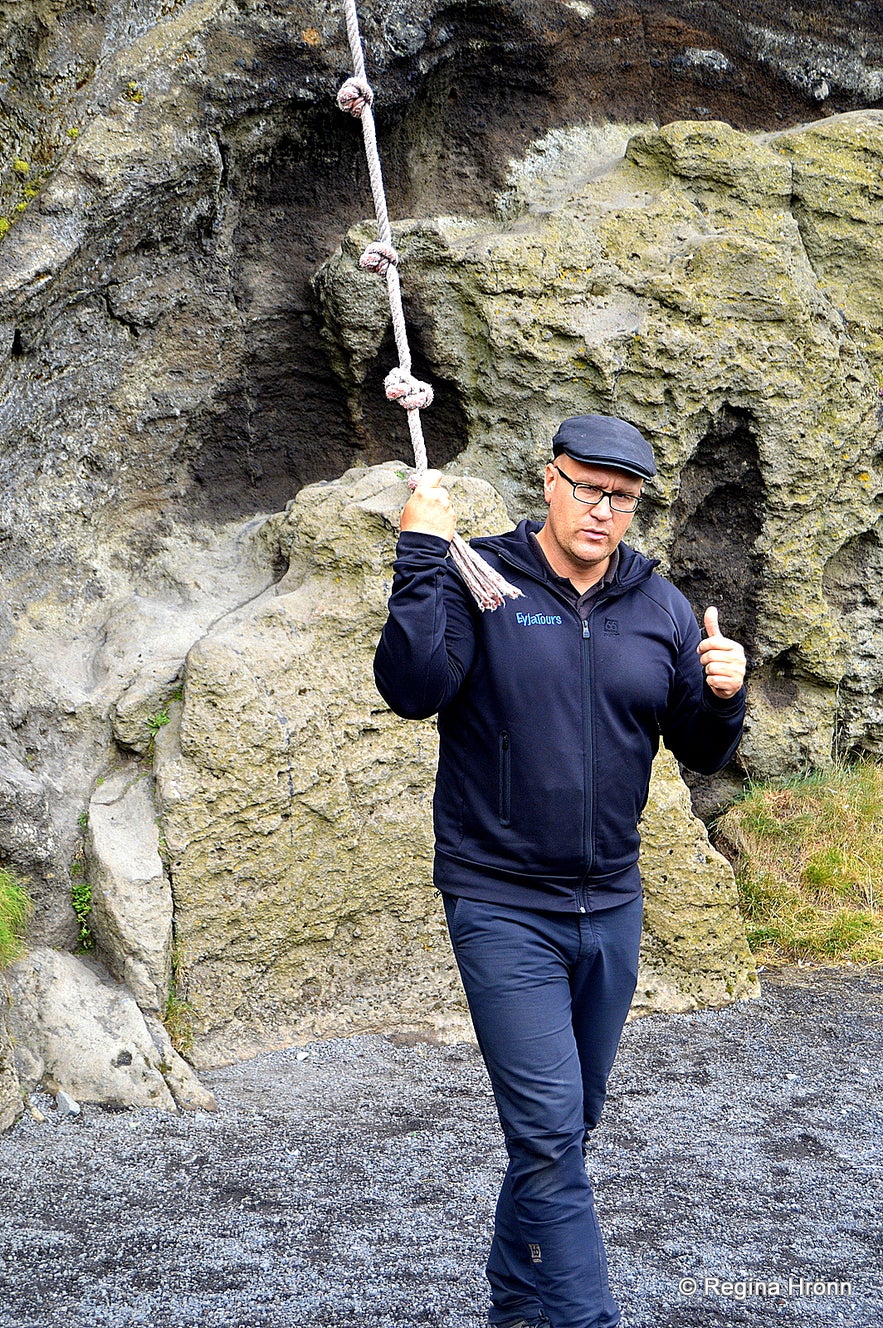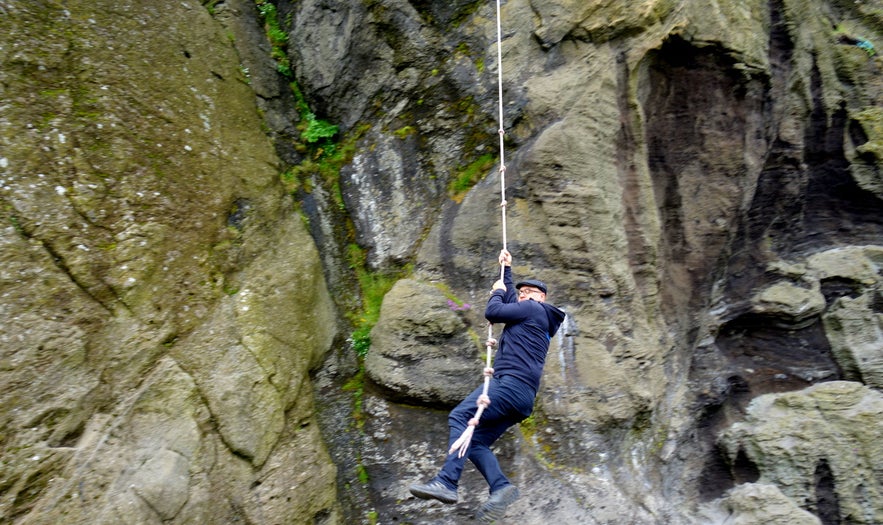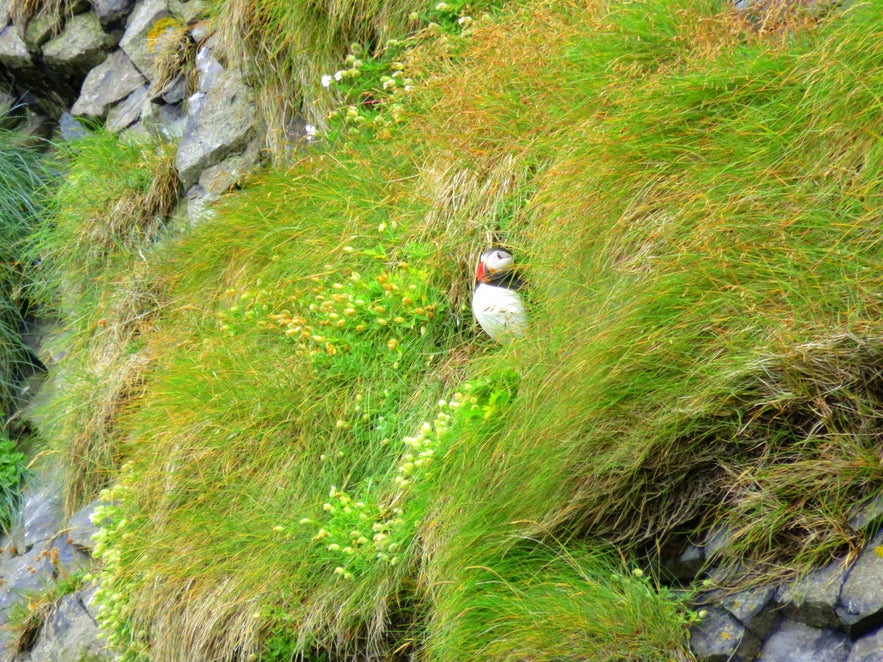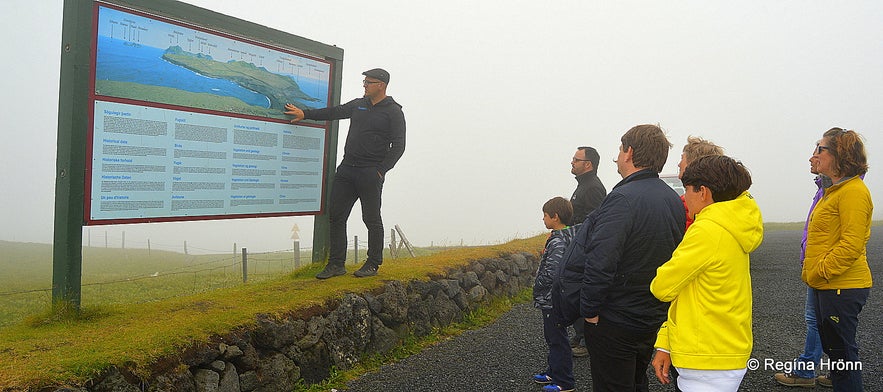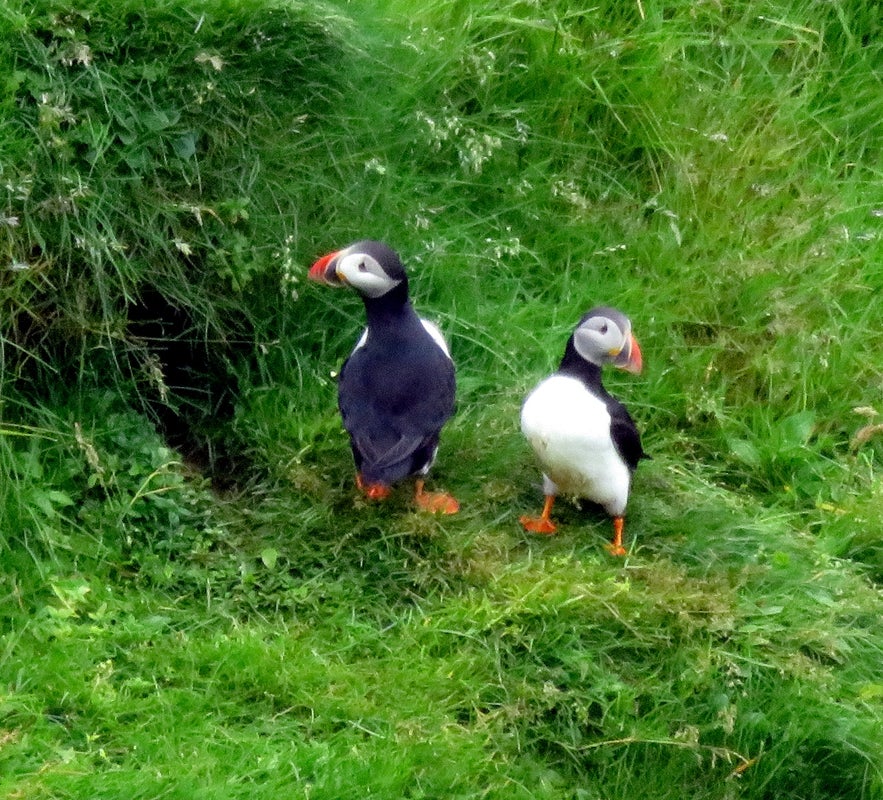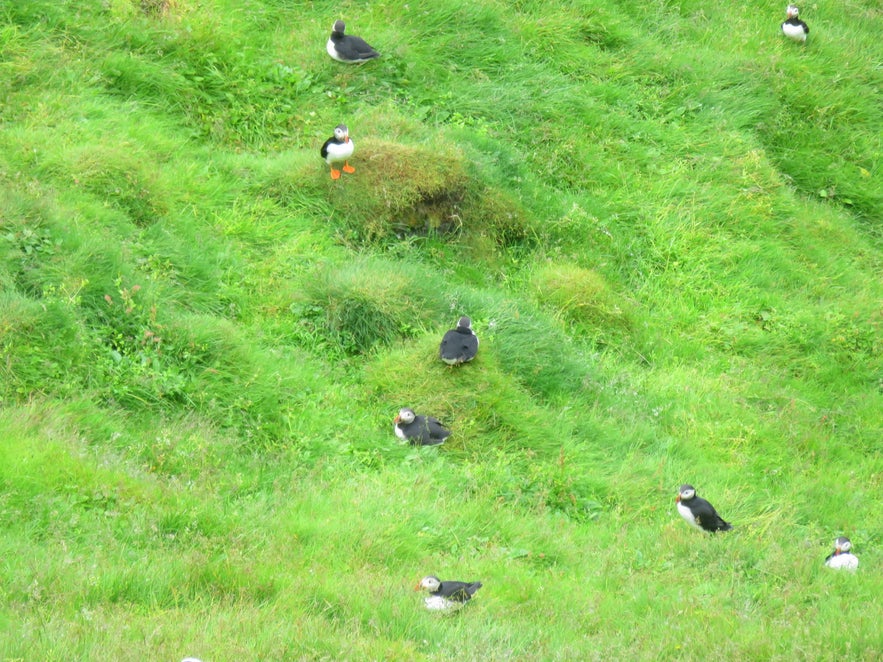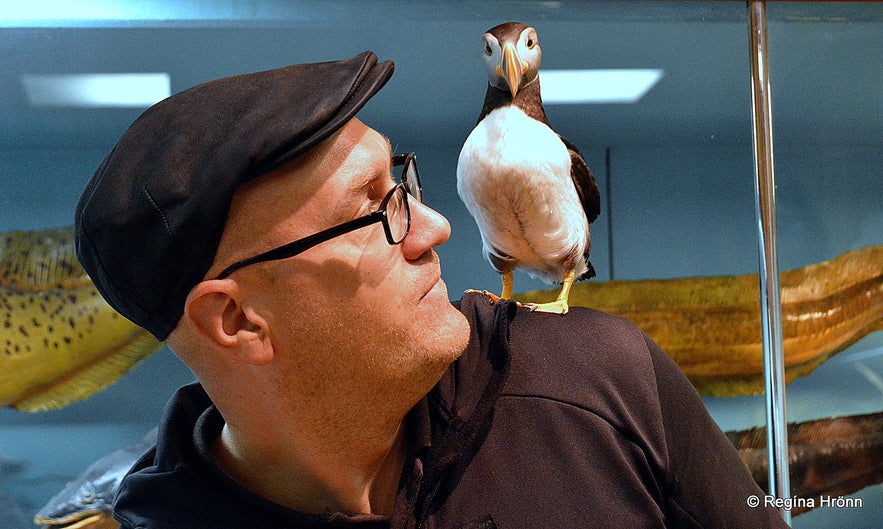
The Westman islands in Iceland - the Puffin and Volcano Tour - Local Guidance
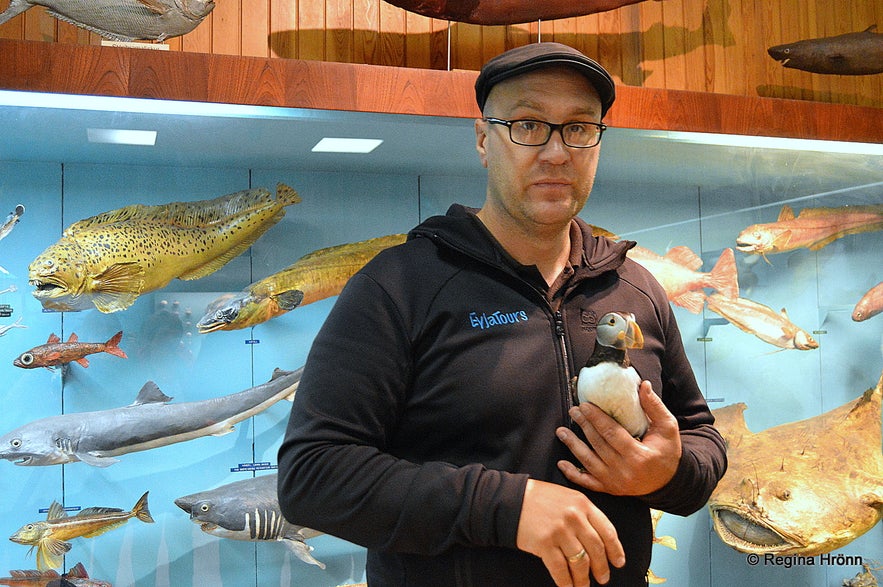
While visiting the Westman Islands I joined one of the tours of the islands to be able to better tell you what these interesting islands have to offer.
I contacted Eyjatours, which is a family company in the Westman Islands, as there is nothing like local knowledge and guidance. I opted for their most popular tour, the Puffin and Volcano Tour.
Top photo: Einar with Tóti the Puffin
 The ferry Herjólfur sails to the Westman Islands
The ferry Herjólfur sails to the Westman Islands
The highlights of this tour are: Sprangan, - Stórhöfði, the windiest place in Europe, - Mt. Eldfell volcano, - Herjólfsdalur valley, - and the friendly puffin Tóti at the Sæheimar aquarium. Unfortunately, Tóti the Puffin has passed away :(
We met up with the guide and owner, Einar, nickname Ebbi, at the offices of Eyjatours, and off we went to explore the Westman islands.
We were driven around the island and the guide told us about the colourful history of the islands and the locals. Our first stop was at Sprangan.
Sprangan

Einar by Sprangan
There is a local islander sport (it can also be called local islander acrobatics) in the Westman Islands, called sprang or rope swinging.
It is like a miniature version of cliff rappelling. One can practice the "sprang" at a location in Heimaey island called Sprangan.
Our guide Ebbi has lived in the Westman Islands his whole life and knows this sport well so he showed us how to "spranga". And of course, having practiced it since he was a boy he was excellent at it.
Einar is of course an expert in this sport
Here the Islanders (Eyjamenn) used to practice before they went on the dangerous task of picking birds-eggs in the rocks.
At Sprangan there are ropes on the rocks where you can try it out for yourself. And believe me it is not easy at all.
I tried it once and must be so much out of shape as I could barely lift myself up, and there was no chance that I could swing myself back and forth towards the walls of the cliff. I honestly felt like I would be ripped apart, what a weakling I am, eh!
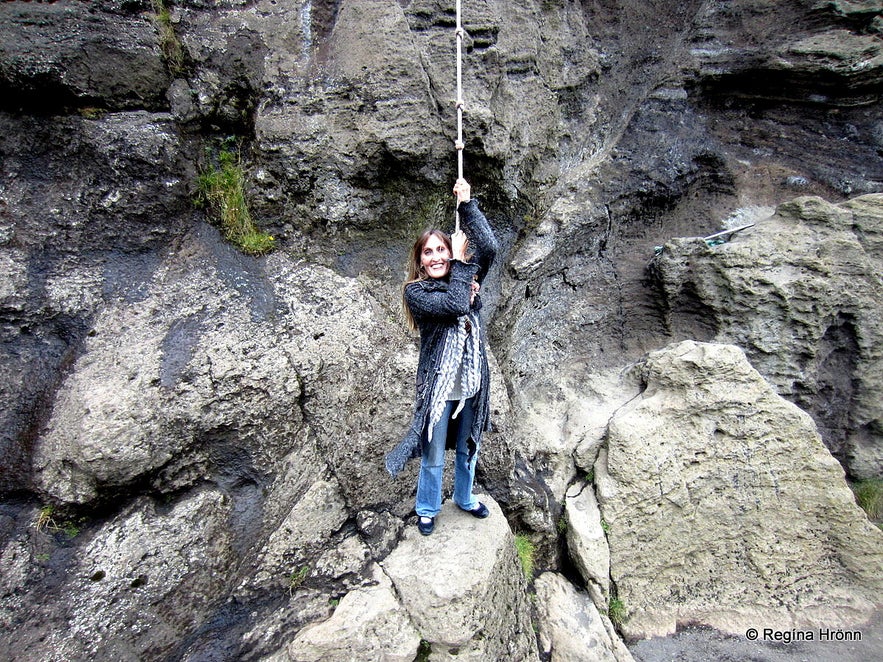
I am very bad at this sport ;)
It is written on a sign by Sprangan that people are here on their own responsibility as this is not easy and can be dangerous if not done right. So maybe it is best to leave this sport to the locals ;)
Kaplagjóta hollow 
By Kaplagjóta hollow
Next, we visited Kaplagjóta hollow, a beautiful spot with a tragic history.
Kaplagjóta in Icelandic means Mare's Hollow and the name derives from horses being thrown into the hollow and drowned here to dispose of them, as it were.
Horsemeat, which is eaten in Iceland, was forbidden for consumption here for a long time in the olden days, so the only way to get rid of "excess" horses was to drown them.
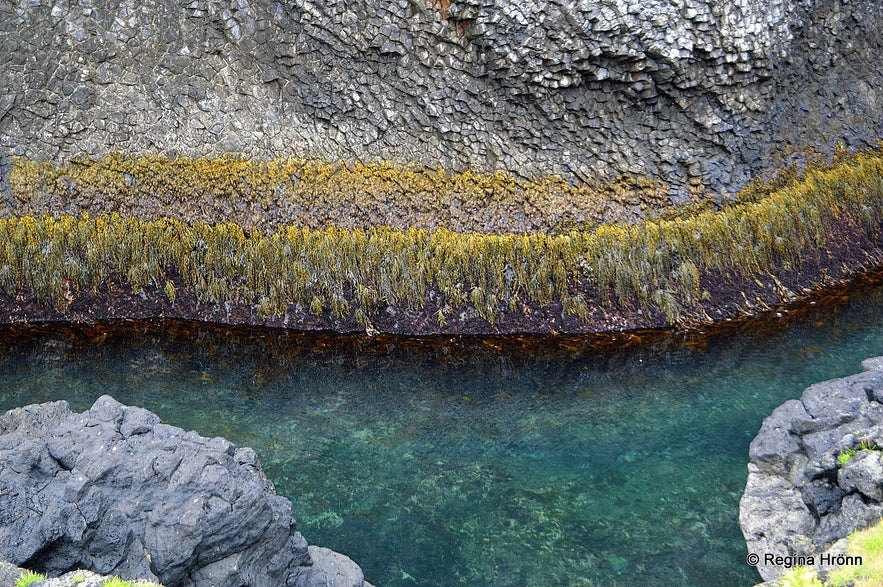
By Kaplagjóta hollow
It was decided in 1528 at the assembly in the Westman Islands, Vilborgarstaðaþing, that there should be no more than 16 horses on Heimaey Island.
The owners of "excess" horses had 14 days to get rid of them. So those horses were then pushed into this hollow and drowned in it.
It looked so beautiful on the day we visited and it is so sad to imagine what happened here to these poor horses :(
Puffins in the Westman islands
I found a ghost story on the Vestmannaeyjar - the Westman islands - website Heimaslóð - it is in Icelandic so I am going to translate it for you, so when you join this tour you will know about the Tíkartáa-ghost, who has been seen doing somersaults into Kaplagjóta hollow:
"In the south-eastern part of Mt. Dalfjall - above Kaplagjóta hollow, there are grassy hills, which have been named Tíkartær. For the longest time, a ghost was often seen there. A weak boy had been sent up to the mountain to catch puffins.
He didn't want to go but eventually gave in after he had been almost forced to go. He fell and crashed in Tíkartær and lost his life and hunted this place after his death. He was often seen doing somersaults from Tíkartær and into Kaplagjóta hollow, but he never harmed anybody that we know of".
When you visit Kaplagjóta hollow keep this in mind!
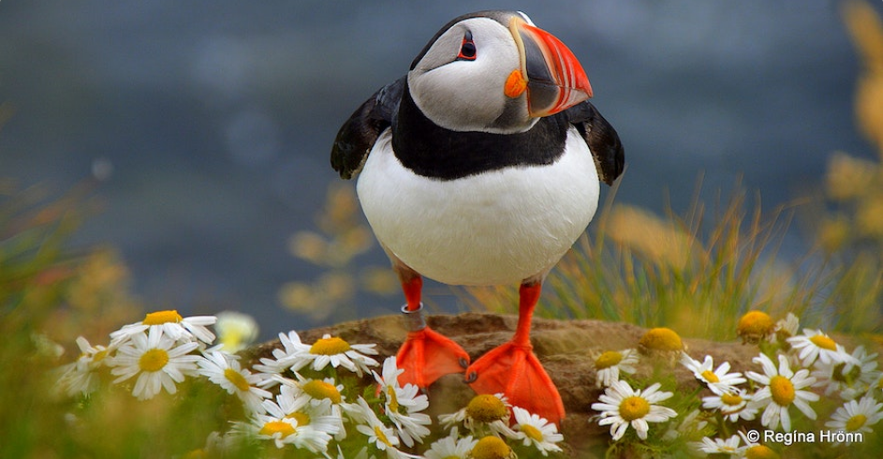
The only thing I saw was some cute puffins in the hills above Katlagjóta hollow.
In the Westman Islands, you will find one of the largest puffin breeding colonies in the world - around 1.1 million birds - and we were to see many more puffins on this tour.
Ebbi also told us about the big, very popular festival held every year in Herjólfsdalur valley, Þjóðhátíð í Eyjum, and when we visited in late July the inhabitants of the Westman islands were busy preparing for that festival which is held in the first weekend of August.

Herjólfsdalur valley
In Herjólfsdalur valley there is a replica of the homestead of the first settler in the Westman Islands, which Ebbi also pointed out to us.
In 2023 Ebbi opened up a Viking museum in Herjólfsbær - Herjólfstown. I visited the museum, talked to Ebbi about this new project, and checked out the Vikings at the museum.
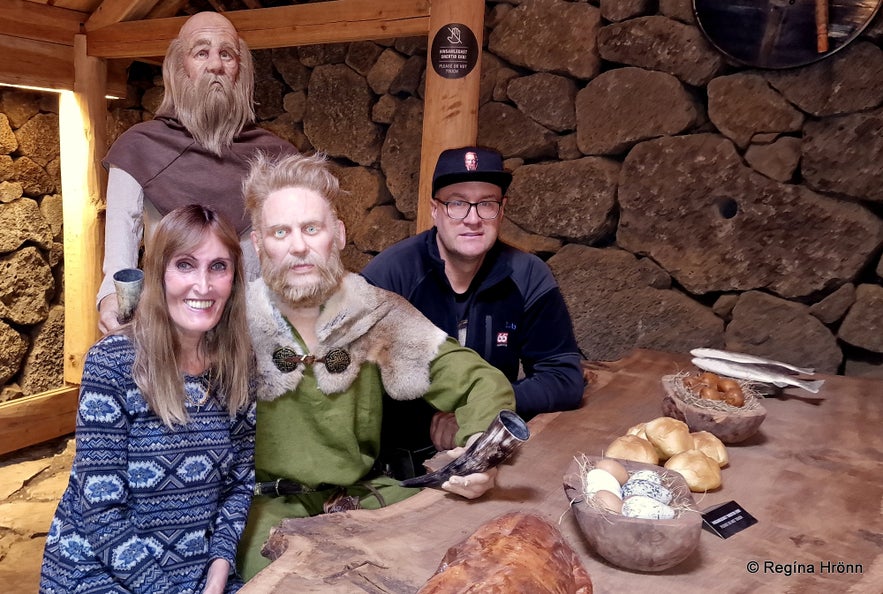
With Ebbi and the Vikings at Herjólfstown
I have written another travel-blog on the settler Herjólfur Bárðarson and his Viking homestead in Herjólfsdalur valley.
Stórhöfði - is this the windiest place in Europe?

On the guided tour in fog
We now visited Stórhöfði, which has been called the windiest place in Europe.
There is much more wind there than ever in the Vestmannaeyjabær town, so when we see the weather forecast for Iceland it sometimes looks like the Westman islands are blowing away, but that is because they measure the wind at Stórhöfði, and not in town.
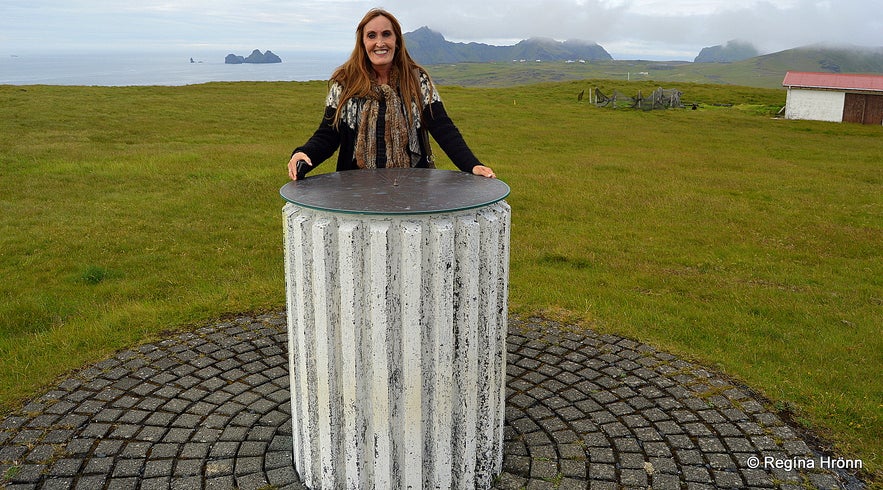 The view-dial at Stórhöfði cape
The view-dial at Stórhöfði cape
It was so foggy during our visit and as we ascended up to Stórhöfði we were in the middle of the fog. If you look at my photo above then Ebbi was actually showing us a beautiful view of the islands as can be seen on the map he is pointing at. We saw absolutely nothing ;)
But I have been up there when the visibility has been much better and I can tell you that it is a beautiful spot.
Puffins in the Westman islands
We didn't venture out on Stórhöfði cape itself where there is also a very good view, seeing that it was so foggy, but I have written about Stórhöfði and other places in my first travel-blog of the Westman Islands' series, which you can look up to see what Stórhöfði actually looks like.
We descended a bit and visited the popular "lundaskoðunarhús" - the puffin observation tower - where you can be on the outlook for the big puffin colony during their breeding season in the Westman islands - there was a myriad of puffins in this place.
Puffins in the Westman islands
I have only been to the puffin observation tower once before, in September, when the puffins had left the islands, and it was amazing seeing all the puffin holes in the grassy hills, but the puffins don't make nests for the egg, instead, they make holes or burrows in the ground.
The puffins can be seen in the Westman Islands during their breeding season from mid-April and until mid-August.
The Westman Islands are after all believed to be the biggest puffin breeding colony in the world - or at least in Iceland, so this place is a must-visit for those of us who love the puffins!
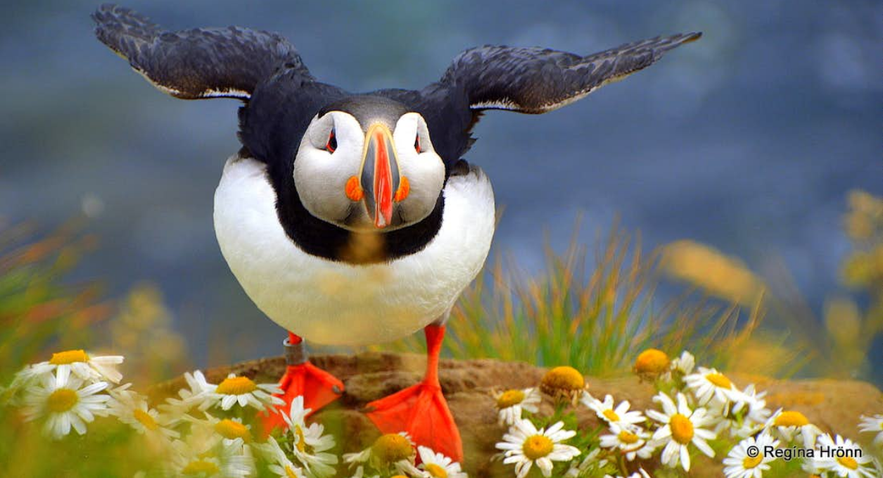
My photos of the puffins are not good as there was so much fog, but I also add photos I have taken of puffins in other places in Iceland.
Just remember that many of the puffins are out at sea during the day, so you will not be seeing 1.1 million puffins in one go.
The volcanic eruption in 1973
On the guided tour
Our next stop was above Vestmannaeyjabær town and while overlooking this lovely town Ebbi told us about the natural disaster which took place here when a volcanic eruption started in 1973 on Heimaey island.
The volcanic eruption lasted from the 23rd of January until the 3rd of July and is the only volcanic eruption to start in a town in Iceland.
The inhabitants had to be evacuated immediately and many of their houses got buried under the lava and cinders.
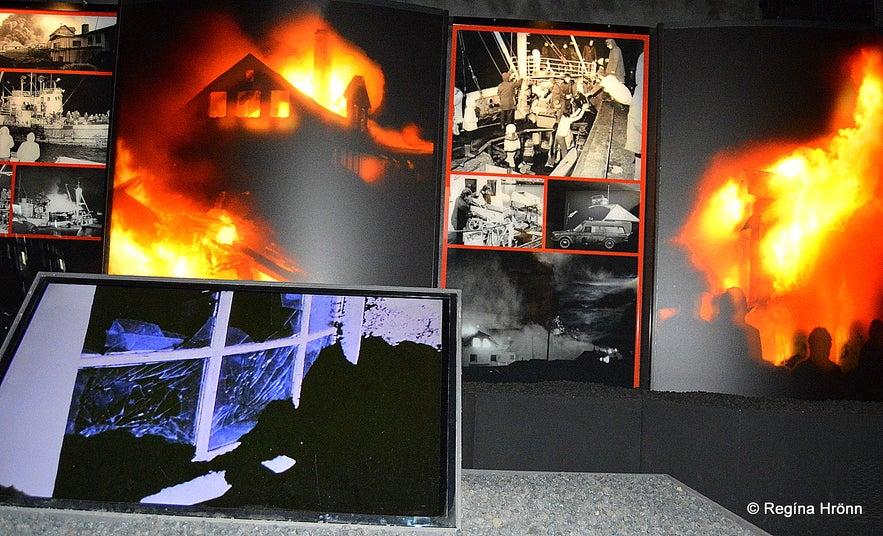
Eldheimar museum
More than 400 houses got buried under the lava and in some areas, people's homes got buried under 3-10 meters of cinders and pumice.
Some of them have been excavated and you can see one of these houses at the Eldheimar - the Pompei of the North Museum, which I had visited earlier that same day. I took the photo above of the volcanic eruption in 1973 at that museum.
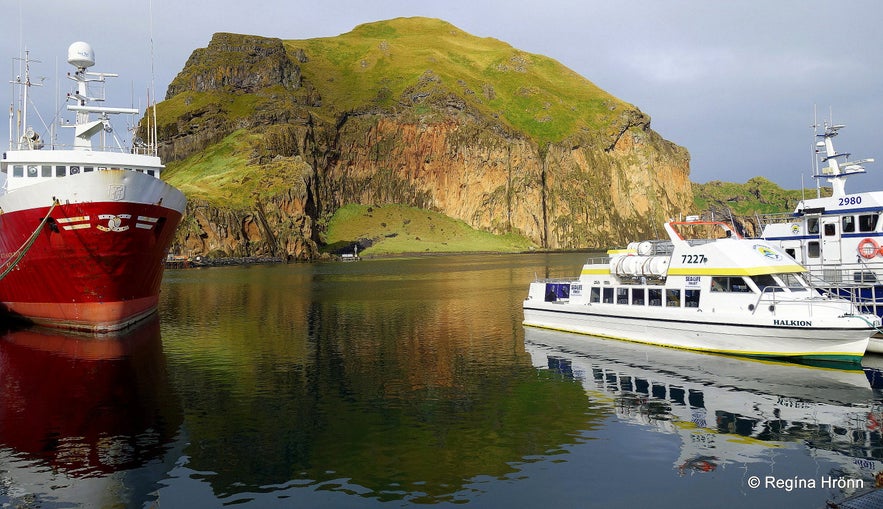 Vestmannaeyjar harbour
Vestmannaeyjar harbour
There was a grave possibility that the lava flow would close the mouth of the harbour or head further in the direction of the town.
Pumps were used to cool down the edge of the lava flow two weeks after the volcanic eruption started.
You can see one of the pumps in my photo below, but we stopped by it on the tour.

One of the pumps used for cooling down the lava flow
It is believed that 6.2 million tonnes of seawater were pumped up and sprayed upon the lava flow. This was a dangerous task, being so close to the lava, so there were some brave men at work here.
Mt. Eldfell volcano
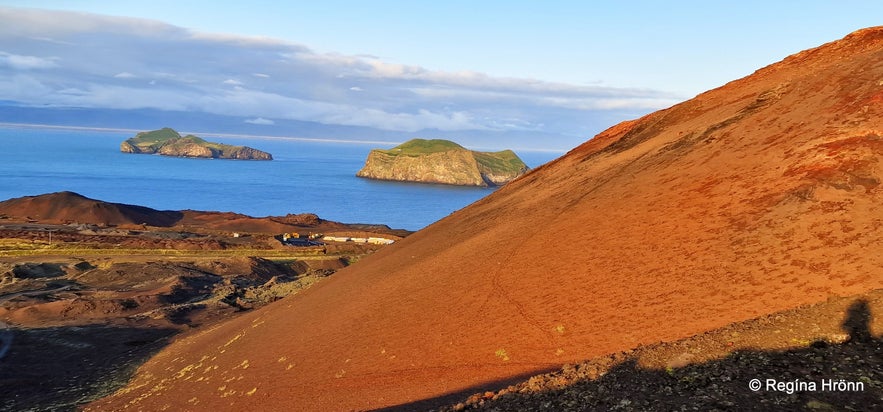 Eldfell volcano on a sunny day in 2023
Eldfell volcano on a sunny day in 2023
We now drove up to the volcano Eldfell and stood almost in the middle of the volcano! There is amazingly colourful lava in, on, and by this volcano. The fog followed us, but later that same day it became almost clear.
We had a short stop here and took photos of the colourful lava while Ebbi told us stories from the volcanic eruption in 1973 when Eldfell got created and spewed out lava and ash over the populated area of Heimaey island.
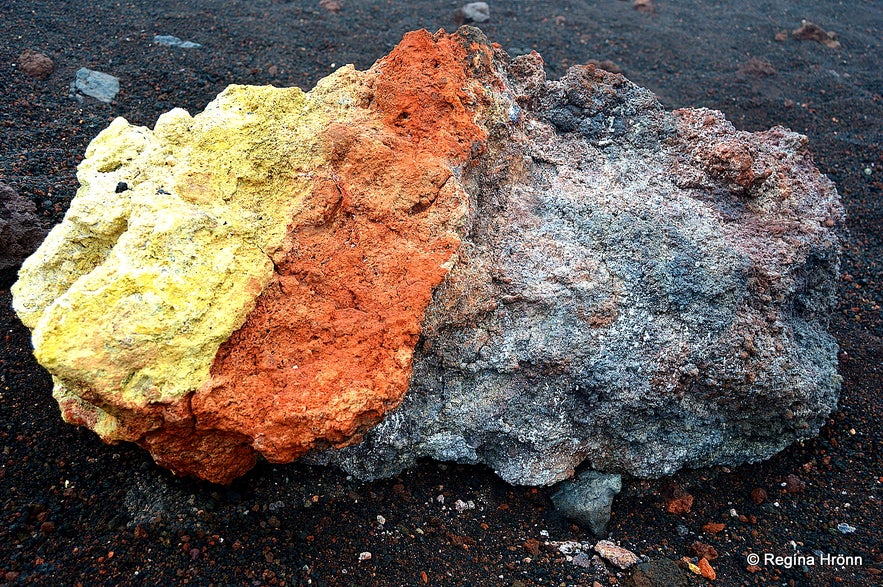
Colourful lava rock - unfortunately, this rock was broken in half when I last visited it in 2020
Ebbi also explained to us what the different lava colours meant; the lava is first black, then red, and sulfur lava, which is orange to yellow, means the end of the volcanic eruption.
Ebbi took a family photo by one of the big, colourful lava rocks. 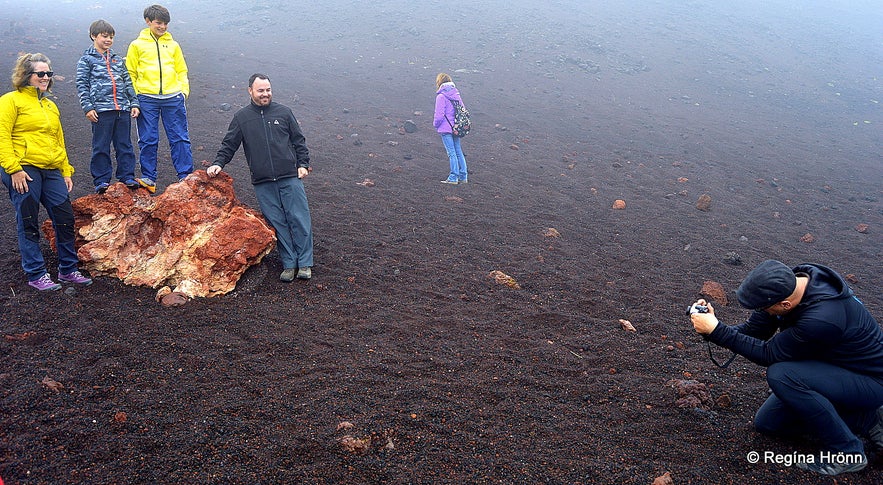
See how foggy it was during our visit
I came across a review on this tour on Tripadvisor made by the family on my tour, so I wrote to them and got their names and approval for posting my photos of them in my travel-blog.
Their names are from the left: Laura Thompson, Quinn and Miles, and Paul Thompson from Decatur, Georgia USA; thank you for being photo models for my travel-blog :)
A video I took of Eldfell volcano in the fall of 2023
I am always amazed to see the big chunks of this colourful lava; this lava looks so beautiful and this area is so serene, but just imagine what it must have looked like during this terrible volcanic eruption back in 1973!
There were even lava bombs flying around which set the houses of the inhabitants on fire :(
I found a lava bomb on display at the Sæheimar museum, which was our next stop on this tour.
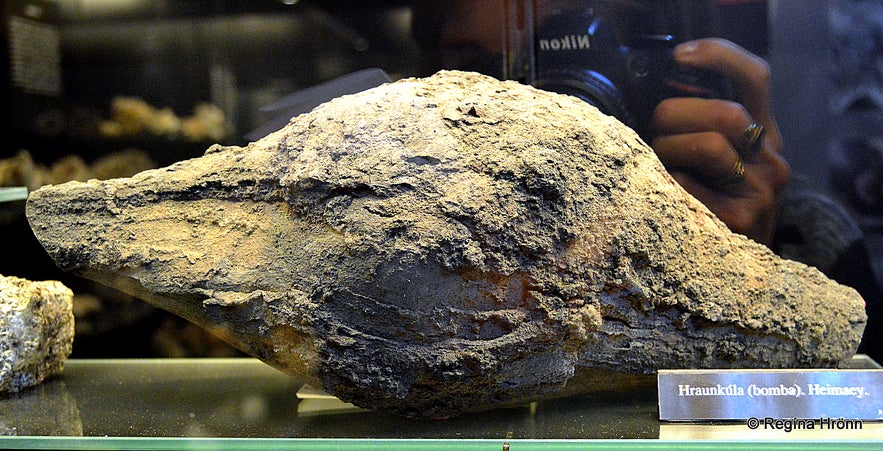
Lava bomb at the museum
I have written about my hike up to the top of this small, but powerful volcano in another travel-blog. The view from the top is amazing and the colourful lava formations up there are out of this world!
Sæheimar and Tóti the Puffin - RIP Tóti :(
Ebbi with Tóti
Our final stop on this educational tour of the Westman islands was at the Sæheimar museum, which I had visited earlier in the morning, where we got to meet Tóti the Puffin :) What a lovely little bird, who sadly passed away recently :(
Tóti was found abandoned in a puffin colony when he was only 1 week old, so he must have hatched 6 weeks later than the other pufflings.
Just imagine this poor little, abandoned puffling wandering around so small at the end of the puffin season when the other much bigger pufflings were about to leave their nest.

Miles Thompson from the USA
Tóti was a good friend of our guide Ebbi and welcomed him when he brought visitors to the museum. Ebbi is one of the few people who got to hold Tóti and it was fun watching them together as Tóti was so excited about seeing Ebbi; it was almost like Tóti was telling him about the things that had happened to him since the last time they saw each other :)
The puffins have an oil gland by the root of their tail and if they are petted they can lose the oil from their feathers, but the oil is there to protect them.
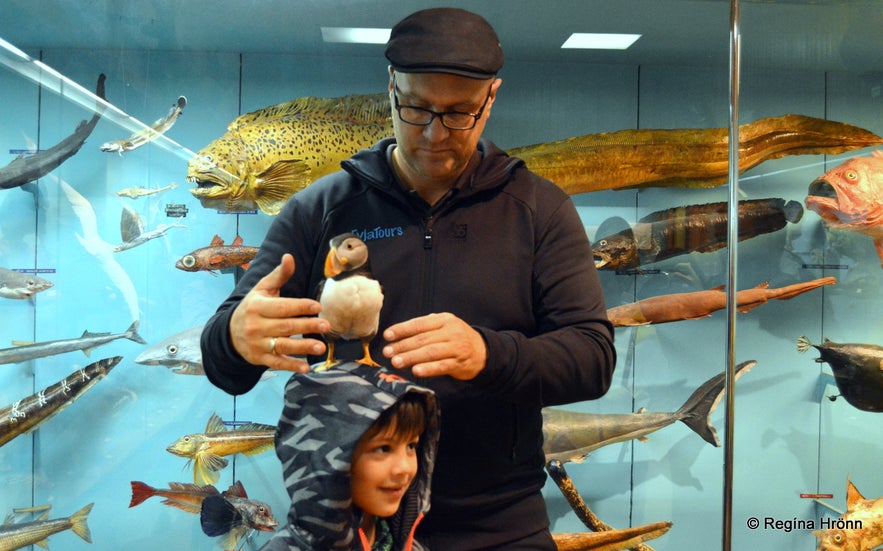
Quinn Thompson from the USA.
So only a handful of people are allowed to hold Tóti. Ebbi picked out the children in our group instead and put Tóti on top of their heads :)
You could take photos of Tóti the puffin, but there are a couple of things that we have to make sure of when meeting a puffin up close - such as not using the flash as it is not good for their eyes.
Visiting the Baluga sisters at the Sea Life Trust Beluga Sanctuary
After meeting Tóti our guide Ebbi left us at the Sæheimar museum so we could explore this small, but lovely museum further.
The museum has now closed down and parts of it are in the Sea Life Trust Beluga Sanctuary by the harbour, which I recommend visiting.
The Puffin and Volcano tour is available from the 20th of April until the 20th of September and lasts for 1.5 - 2 hours. It is a short and very informative tour, which should most definitely be included in a visit to the Westman Islands.
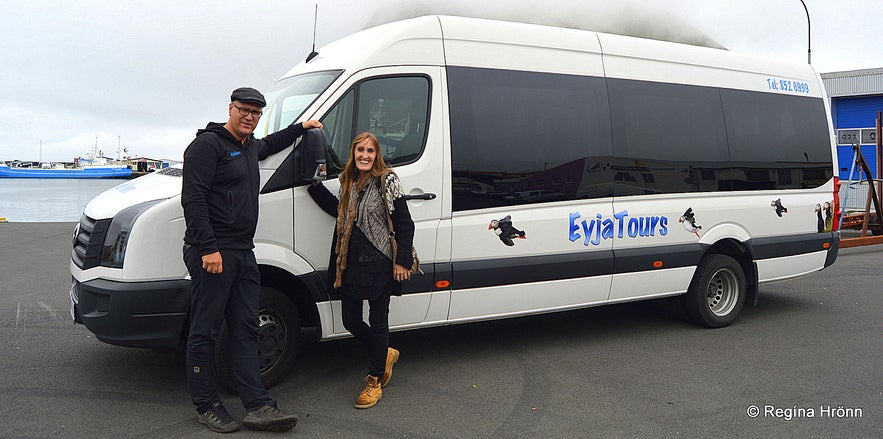
Thank you, Ebbi, for a lovely tour :)
In my opinion, local knowledge is priceless and after the tour, one can explore the islands further with much more knowledge of the most interesting places on the Westman Islands. You can also opt for a private tour of Heimaey Island.
其他有意思的博客
冰岛最浪漫的角落
对于很多人,遥远的冰岛有着世界尽头的神秘,有着区别于巴黎、马尔代夫、自成一体的浪漫。没有埃菲尔铁塔和蒂凡尼,没有热带沙滩,而是在冰川、火山、苔藓地的背景下蜜月旅拍、婚拍,甚至举办一场冰岛婚礼。来冰岛旅行,多是要跨千山万水、飞跃大洋大陆,很有一点“万水千山陪你走过”的史诗感。难怪很多人说,光是冰岛二字,就足够浪漫了。 冰岛虽然不大,但是地貌极其丰富,不同的自然景观自然有不同的气质。这一篇,就挑阅读更多从极光观测到摄影-到底该不该来冰岛看极光
很多朋友都想来冰岛看极光,但是冰岛到底适不适合看极光呢?几月、什么季节能看到极光?是不是一定要参加北极光旅行团?如何能拍摄出美丽的极光照片呢?在冰岛住了好几年了,从刚开始逢极光必出门,到如今家里阳台就能看极光,我对在冰岛看极光的了解和经验,也算得上大半个专家了,且听我娓娓道来吧。 到底该不该来冰岛看极光呢?最坦诚的答案是,不要只为了看极光而看极光。 极光原理 太阳活动→太阅读更多
迷失冰岛的米湖游览推荐|不只有温泉的地热宝藏区
我在冬夏秋均到访过米湖,看过米湖的不同面。一直以来,米湖到底值不值得去是很多游客争论的问题。有些人觉得这里是来冰岛旅行的必去目的地,有些人则说米湖“太丑了”,连照片都不想多拍几张。那米湖到底值不值得来呢?到底怎么玩呢? 米湖的风景 北部的米湖,因地理位置相距首都雷克雅未克略远,很多来冰岛的短途游客选择放弃,其实米湖应该是和黄金圈、南岸沿线至冰湖齐名的冰岛景色,这里冷热相融,可谓最冰岛,尤其阅读更多

将冰岛最大的旅行平台下载到您的手机中,一站式管理您的整个行程
使用手机摄像头扫描此二维码,然后点击显示的链接,将冰岛最大的旅行平台添加到您的手机中。输入您的电话号码或电子邮件地址,以接收包含下载链接的短信或电子邮件。

